Game Interface & Features
The Lab Manager game interface primarily consists of two parts, the technology tree on the left and the management column on the right.
The technology tree is a visual representation of the hierarchy of the different technologies that the player has to research. As the player researches the technologies, one or more technologies get unlocked along the way. The technology boxes in green indicate that they have been researched, yellow are the new technologies that are accessible and red are not accessible yet. The number of technologies that get unlocked depends upon whether the pre-requisite technologies have been researched. For example, for ‘’Cold Atom interferometry’’, you have to finish researching both ‘’Hot atom interferometry’’ and ‘’Sub-doppler cooling’’. In the picture below, it is seen that you have finished researching only ’Sub-doppler cooling’’ (denoted by green colour), so unfortunately you cannot unlock ‘’Cold Atom interferometry’’ yet. Some technologies also require special equipment, so unless you have purchased that, it cannot be researched.
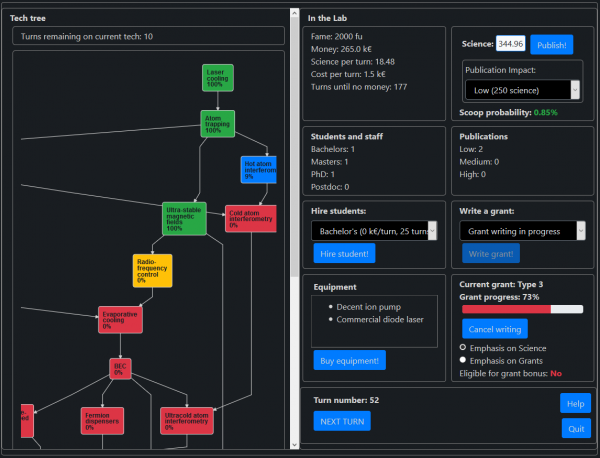
In the management column, players must maintain a balance between science, fame and money while researching technologies. This can be done by making choices regarding:
-
- Hiring students
- Writing grants
- Writing publications
- Purchasing equipment
There are also random events (positive and negative) that can cause players to change their strategy. Pop-ups will announce these events at random times during the game.
Below are screenshots of some choices and pop-ups you see in the game.
Hiring students
You can hire students to work in your lab, starting from Bachelor students to Postdocs. Each student has a science rate (positive or negative) and cost associated with them. Therefore, with each turn, science and money get impacted depending on the student you hired. Students hired earlier can also be promoted.
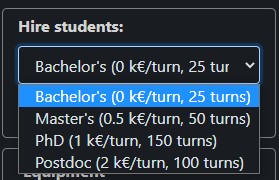
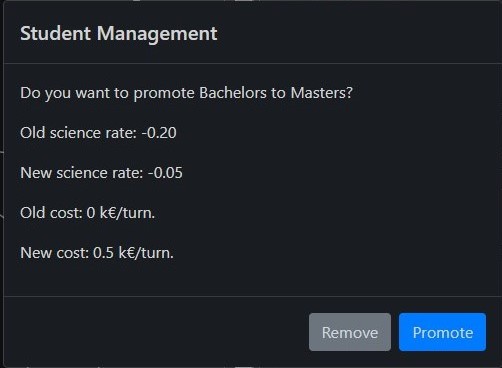
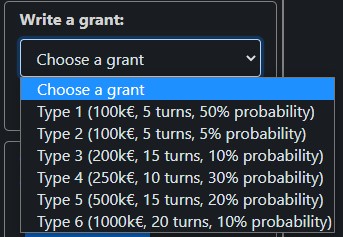
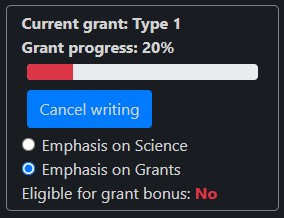
Writing grants
You can choose to write any type of grant, ranging from a basic to a top-tier grant. A basic grant has a higher acceptance chance while the top-tier grant has a lower acceptance chance but more money! Now, imagine this - you need money as your lab has only 86.5 k€ and you want to apply for an advanced grant as that will earn you 500 k€, but it will take 15 turns to write the grant, and there is a 25% acceptance chance. However, you can also apply for a basic grant of 100 k€ because there’s a 50% chance of getting it and will only take 5 turns! The downside is here that you have to apply for grants again and again to reach 500 k€. Which option would you choose? Also, remember that each turn costs some amount of money based on how many students you have. If you have limited turns left or less money, you must make the optimal choice.
Publish!
As you progress in the gameplay, you will research different technologies and collect ‘’Science’’ units. Based on the number of units, you can choose to publish a paper about your research in a low, medium or high-impact journal. Each of these options require a minimum number of ‘’Science’’ units. For example, a medium-impact journal requires a minimum of 500 points while a high-impact journal requires a minimum of 1000 points. Every time you publish, you gain some ‘’Fame’’ units.
To illustrate an example, you have 1877 ‘’Science’’ units and you have the option to choose to publish in a low, medium or high-impact journal. You could either go for 1 high-impact and 1 medium-impact publication or 3 medium-impact publications. Whichever option you choose, it will impact your ‘’Fame’’ units and the likelihood of getting grants.
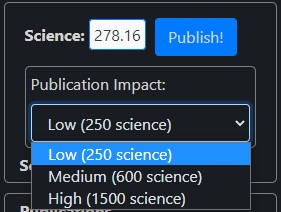
Purchasing and upgrading equipment
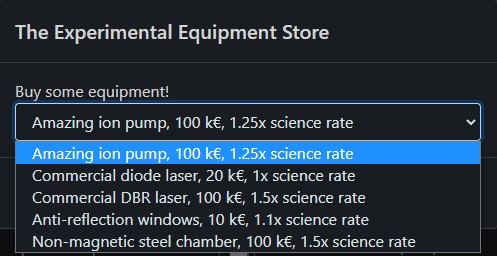
You can purchase new equipment and increase your science units! This way, you can publish more papers and choose between publishing in a low-, medium- or high-impact journal. As you publish more papers, fame increases and your likelihood of getting a grant also increases. You can also get equipment upgrades as you research the different technologies.
Random events
During the gameplay, there could be random events that impact your strategy. These random events could be both positive or negative. For example, a negative event could be that a laser breaks down, which reduces your science as you have to replace the broken laser, and it reduces your money as well because you have to buy or build a new laser. On the other hand, a positive event could be that you are invited to give a talk at a prominent conference and you gain fame units!

